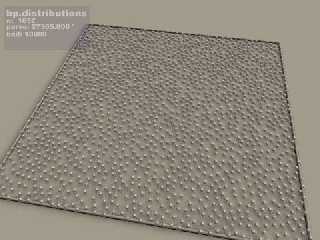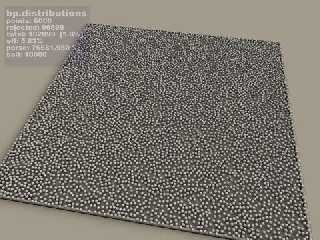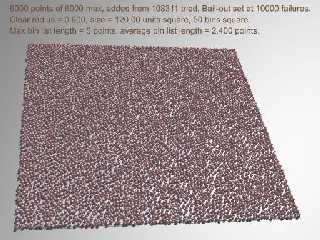 |
 |
|
 |
|
 |
|  |
|  |
|
 |
|
 |
|  |
|  |
|
 |
Xplo Eristotle wrote:
<snip/>
> Because of the random nature of the code and the need to test against
> every other tree when placing a new one,
<snip/>
A more recursive, fractal approach might help cull the amount of trees
you need to test against. How a "plasma" fractal is created might help
you build the algorithm:
http://www2.vo.lu/homepages/phahn/fractals/plasma.htm
I think the "wrinkles" pattern in POV-Ray is a 3D representation of a
plasma fractal (probabally uses a Gaussian (bell-curve) Distribution as
well because I don't see "pyramids" in the pattern. Perhaps the POV-Ray
code might help generate some ideas on this too?
--
Respectfully,
Dan P
http://<broken link>
Post a reply to this message
|
 |
|  |
|  |
|
 |
From: Xplo Eristotle
Subject: Re: Forest generation (or; crude packing)
Date: 30 Mar 2004 19:59:38
Message: <406a17fa@news.povray.org>
|
|
 |
|  |
|  |
|
 |
Dan P wrote:
> Xplo Eristotle wrote:
>
>> Because of the random nature of the code and the need to test against
>> every other tree when placing a new one,
>
> A more recursive, fractal approach might help cull the amount of trees
> you need to test against. How a "plasma" fractal is created might help
> you build the algorithm:
I don't see what use this could possibly be. But then, it's possible
that the math that would make its application obvious is over my head.
*shrug*
-Xplo
Post a reply to this message
|
 |
|  |
|  |
|
 |
|
 |
|  |
|  |
|
 |
Xplo Eristotle wrote:
> Dan P wrote:
>
>> Xplo Eristotle wrote:
>>
>>> Because of the random nature of the code and the need to test against
>>> every other tree when placing a new one,
>>
>>
>> A more recursive, fractal approach might help cull the amount of trees
>> you need to test against. How a "plasma" fractal is created might help
>> you build the algorithm:
>
>
> I don't see what use this could possibly be. But then, it's possible
> that the math that would make its application obvious is over my head.
> *shrug*
It's a matter of finding a way to limit the size of your arrays by
slicing the the scene up into smaller and smaller cubes by using
recursion to some pre-defined limit.
--
Respectfully,
Dan P
http://<broken link>
Post a reply to this message
|
 |
|  |
|  |
|
 |
|
 |
|  |
|  |
|
 |
can i show mine?
i did this ages ago, and was planning to make some improvments to my
otherwise totally brute force method, but i was pleased enough with the
final image anyway. Sorry, i've probably lost the source, but i could
have a dig around for it.
(in the top left panel, n is the number os dots, parse is the time it
took to parse in seconds, i think, and bail is the amount of times it
has failed and then bailed out to start rendering. Jeepers - it looks
like this one took around 7 hours to generate!)
benp
Xplo Eristotle wrote:
> I'm working on some code to pack a number of objects - presumably
> vegetable-based, but I guess a person could pack anything they want -
Post a reply to this message
Attachments:
Download 'hwdistributions3b.jpg' (34 KB)
Preview of image 'hwdistributions3b.jpg'

|
 |
|  |
|  |
|
 |
|
 |
|  |
|  |
|
 |
and...
bp wrote:
> can i show mine?
> i did this ages ago, and was planning to make some improvments to my
> otherwise totally brute force method, but i was pleased enough with the
> final image anyway. Sorry, i've probably lost the source, but i could
> have a dig around for it.
> (in the top left panel, n is the number os dots, parse is the time it
> took to parse in seconds, i think, and bail is the amount of times it
> has failed and then bailed out to start rendering. Jeepers - it looks
> like this one took around 7 hours to generate!)
> benp
>
Post a reply to this message
Attachments:
Download 'hwdistributions3_reallyfine.jpg' (55 KB)
Preview of image 'hwdistributions3_reallyfine.jpg'

|
 |
|  |
|  |
|
 |
|
 |
|  |
|  |
|
 |
Now the second one rocks! Can't see the parsing time properly, but it
must have been quite some days :)
Florian
Post a reply to this message
|
 |
|  |
|  |
|
 |
From: Florian Brucker
Subject: Re: Forest generation (or; crude packing)
Date: 31 Mar 2004 06:24:45
Message: <406aaa7d@news.povray.org>
|
|
 |
|  |
|  |
|
 |
Xplo Eristotle wrote:
> Florian Brucker wrote:
>
>>> Because of the random nature of the code and the need to test against
>>> every other tree when placing a new one, scenes with a lot of trees
>>> take a long time to parse;
>>
>>
>> A way to improve this would be something like bounding boxes
> I plan to implement something like that, yes...
> ...but not like that. If I'm reading this right, I could accomplish the
> same effect right now by using multiple "forests" stitched together,
> which isn't what I want; the "clear areas" around trees in adjacent
> cells would overlap because those trees don't get checked against each
> other.
> Instead, I would divide the area into sections and only check against
> the trees in the sections near where the new tree is trying to be
> placed.
> .. am I making any sense?
That's what I tried to say with
>> Of course you have to add an object which overlapps a border into
>> both cells it touches.
:)
> I suppose if you
> really wanted to be thorough, you could have a second algorithm take
> over when the first one loses its confidence and walk a fine grid,
> testing each point on the grid to make sure something can't fit there;
> at some point this would be far more efficient than random placement
> that fails over and over again.
I think a totally random approach might be a really bad idea. I thought
more along the terms of "Take a set of cylinders which is in perfect
order. Now find some random translations which can be applied on each
cylinder so that the set looks totally random with as little
intersections as possible".
> 3D is easy. The math gets a little more complicated.
Yep
> 3D using cylinders is easy.. kinda. The math that tests for overlap gets
> even more complicated, but the algorithm basically stays the same.
Sure the tests get more complicated. While you can simply compare the
radius with the distance of two spheres, you have to take the direction
of the main-axis into account when dealing with cylinders. It would not
only be harder to implement, it would also take longer to parse :(
> 3D using cylinders under the influence of gravity which not only moves
> the cylinders but also rotates them when they touch other objects..
Yep. That would be the best result of course :)
> And you may want a sumpercomputer to run the
> simulation... ;)
Got one? Hehe.
I once started trying simulating it with SimPOV, but I couldn't get it
to work properly. Perhaps I'll try again.
Florian
Post a reply to this message
|
 |
|  |
|  |
|
 |
|
 |
|  |
|  |
|
 |
cheers! i'd love to get back to it one day.
i think it says it took 21 hours to parse! (the unit is in seconds..)
bp
Florian Brucker wrote:
> Now the second one rocks! Can't see the parsing time properly, but it
> must have been quite some days :)
>
> Florian
>
Post a reply to this message
|
 |
|  |
|  |
|
 |
From: Michael Andrews
Subject: Re: Forest generation (or; crude packing)
Date: 1 Apr 2004 12:39:45
Message: <406c53e1@news.povray.org>
|
|
 |
|  |
|  |
|
 |
Hi bp,
I've just written a 'bins' based algorithm - it creates sorted lists of
points in a grid of bins. When you want to add a new point it looks in
the appropriate bin or bins to see if any of the current points are
within a given distance of the new point.
Like yours, this image places 6000 spheres. You don't say what the area
size or the clearance radius is for yours, but the total number of tries
is similar enough to mine that the two can be compared.
That said, mine took a little less time to parse - using official PoVWin
3.5 on my 1Ghz Athlon it was 149 seconds! :-)
The most efficient bin size for the algorithm seems to be about four
times the radius - trade off between length of list in each bin and
having to look in multiple bins more often ...
I can post the code if anyone wants to have a look.
Mike Andrews.
<message_pane>
Scene contains 6228 frame level objects; 1 infinite.
Statistics for C:\Program Files\POV-Ray for Windows
v3.5\scenes\array_fill.pov, Resolution 512 x 384
----------------------------------------------------------------------------
Pixels: 197120 Samples: 1055304 Smpls/Pxl: 5.35
Rays: 1055304 Saved: 0 Max Level: 1/5
----------------------------------------------------------------------------
Ray->Shape Intersection Tests Succeeded Percentage
----------------------------------------------------------------------------
Box 1447721 880053 60.79
Cone/Cylinder 379689 12704 3.35
Plane 1684004 1055304 62.67
Sphere 2021823 917211 45.37
True Type Font 59885 30964 51.71
Bounding Box 8636084 3431631 39.74
Light Buffer 32225595 10986256 34.09
Vista Buffer 33004346 19147603 58.02
----------------------------------------------------------------------------
Function VM calls: 445244
----------------------------------------------------------------------------
Calls to Noise: 0 Calls to DNoise: 10
----------------------------------------------------------------------------
Shadow Ray Tests: 1350653 Succeeded: 198742
----------------------------------------------------------------------------
Smallest Alloc: 25 bytes Largest: 49840
Peak memory used: 7897321 bytes
----------------------------------------------------------------------------
Time For Parse: 0 hours 2 minutes 29.0 seconds (149 seconds)
Time For Trace: 0 hours 0 minutes 13.0 seconds (13 seconds)
Total Time: 0 hours 2 minutes 42.0 seconds (162 seconds)
----------------------------------------------------------------------------
CPU time used: kernel 29.69 seconds, user 131.26 seconds, total 160.95
seconds
Render averaged 1221.54 PPS over 196608 pixels
POV-Ray finished
</message_pane>
Post a reply to this message
Attachments:
Download 'array_fill.jpg' (53 KB)
Preview of image 'array_fill.jpg'

|
 |
|  |
|  |
|
 |
|
 |
|  |
|  |
|
 |
For tree "packing" algorithm I would suggest examining this ...
http://www.gingerbooth.com/courseware/pages/demos.html
Especially ...
http://www.cbc.yale.edu/courseware/woods.html
There is a lot of documentation and source code.
Seems a lot more realistic than 2D overhead packing that
relies on only perimeter intersection checking.
Post a reply to this message
|
 |
|  |
|  |
|
 |
|
 |
|  |




![]()